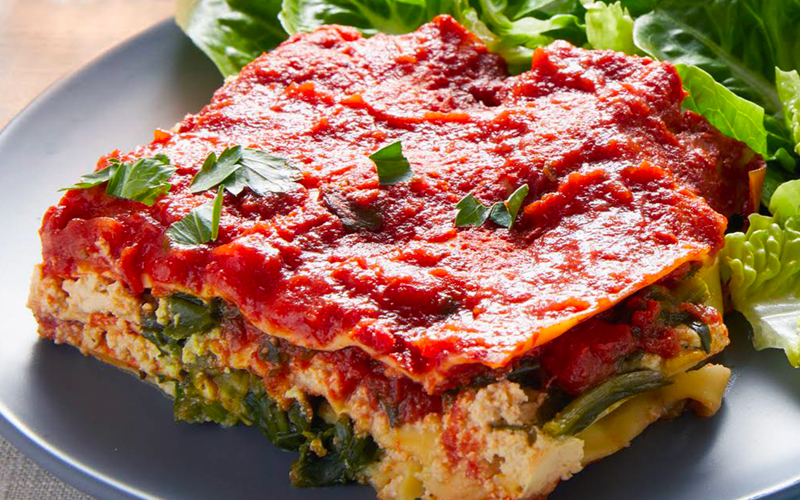Merrily offers advice—and a few confessions—about feeding guests who have food sensitivities.

Have you ever seen the film Gosford Park? I’ve watched it about a hundred times. Written by Julian Fellowes, it’s considered a master study of the British class system and the precursor to Downton Abbey. Among my favorite scenes is when the poseur valet informs the cook and housekeeper that his boss—one of Gosford’s weekend guests, the fussy, neurotic, fur-coat-wearing movie director Morris Weissmann—is a vegetarian.
“A what?” cook says.
“A vegetarian” the valet replies. “He doesn’t eat meat.”
“He doesn’t eat meat?” cook says, highly annoyed. “He comes to a shooting party, and he doesn’t eat meat?”
“Now, now, we don’t want to be thought unsophisticated.” rebukes the housekeeper, played by Helen Mirren. “Mr. Weissman’s an American. They do things differently there.”
A Shift In Attitude
I used to, deep down in my hostess heart of hearts, think that—with the exception of my friend Bernie Ashcraft, the world’s lowest-maintenance vegetarian—anybody with special dietary needs was a little like the faddish Morris Weissmann. I tended to agree with my cooking buddy, the insufferable food snob Don Loncasty, who always gets a laugh when he refers to someone’s food allergy as “a cry for attention.” Of course, he says this as he lovingly alters the recipe to accommodate the allergy.
My thinking has matured as dear friends have developed serious dietary issues. For some of us, eating the most innocent-sounding foods can have dire consequences. You want your precious guests to know they are eating safely and well at your house.
A Teachable Moment for This Hostess
But I am also reminded of a guest I once had at a dinner party who, amidst the rush of getting the meal plated and served, strolled into my kitchen, and asked if he could read all the labels of everything I was serving. When I told him some of the packaging had been discarded, he wanted to go through my trash. I was annoyed at his nerve, but more annoyed at myself. I should have asked in advance if he had special dietary needs.
I never used to ask—is that so wrong?—because I didn’t want to open the hornet’s nest of developing a menu for ten around one person’s pesco-vegetarianism and another’s egg sensitivity. Sometimes food allergies are simply preferences. I have a close chum, for example, whom I’ve noticed is selectively allergic to shrimp. If you put enough curry on it, she is suddenly no longer allergic.
These days if I’m feeding someone new, I do ask about food sensitivities. But I think all hosts can presuppose that if there were a serious allergy, we would be informed without having to ask. I have an old friend whose husband has a horrible reaction to peanuts. When you invite them to dinner, she lets you know before you even get the invitation out of your mouth. And she reminds you every time. And she carries an Epi-pen in her handbag, just in case. Now that’s an allergy.
To Tell or Not to Tell
Call me shallow, but I care more about my social life than I do about the rights of our fellow creatures of the earth, animal, fish, and fowl. I would never become a vegetarian, for fear of getting struck off a great party list for being too high maintenance. Plus, I could never give up bacon.
My aforementioned friend, Bernie, is much more high-minded. “Nothing with eyes” is what she’ll tell you if you ask her directly about her restrictions. But if you invite her to dinner, she usually won’t volunteer that she is a vegetarian because she doesn’t want anybody going to any extra trouble. And that is always the question when an omnivore invites a vegetarian to dinner: should the veg tell the om? I like Bernie’s approach. “There is always plenty of other food. I just eat around the meat,” she says.
“If it’s a smaller gathering, I might let the host know, just to avoid any possible awkwardness, but then I offer to bring an alternate dish.”
Easy, Flexible Menu Ideas
For my part, I would be just as happy to be served a completely meatless meal, as would many of the meat eaters I know. But it seems more hospitable, if you are hosting a guest list that you know includes omnivores as well as vegetarians, and maybe someone gluten-free as well, to provide a flexible main dish. Shrimp Caneel with Creamy Lemon Rice (from Beyond Parsley) is a good such dish because you can leave the shrimp out and it’s still delicious, and gluten-free as well. Gwyneth Paltrow’s Risotto with Peas and Greens is a fabulous meatless, gluten-free main course. Email me for these recipes and any others mentioned herein.
A pasta is perhaps the most classic and easy-to-make dish for a mixed crowd. You could prepare a Bolognese sauce or a meat ragu for the oms, along with a pesto, marinara or a rich mushroom sauce for the vegs. If you have gluten-free guests in the mix, Barilla makes excellent g-free pasta.
A build-your-own pizza party is another viable option, as is a taco bar or a soup party. I have topping and filling lists as well as soup recipes—email me and I happily will send them to you.
Veganism: No Longer Fringe
Once considered an eccentric splinter faction of vegetarians, veganism has become more mainstream in the past decade. Now everyone has some vegans in their lives, and it has become easier to find vegan-friendly food products. (Billie’s Grocery, with locations in Leawood and Midtown, has lots of delicious vegan options, including vegan birthday cakes.) I have a marvelous recipe, yours for the asking, for a three-ingredient vegan cauliflower sauce that is delicious served with pasta.
That being said, the vegans I know are flexible and pretty easy to feed. They eat vegan most of the time but allow themselves the odd bit of dairy, meat, or fish when they are invited to a non-vegan meal.
That Sneaky Gluten
There are various levels of gluten intolerance, but for those diagnosed with celiac disease—and their numbers are on the rise—even the tiniest bit of gluten can be damaging. Serving them a completely uncontaminated gluten-free meal is a responsibility not to be taken lightly. Gluten slithers into all kinds of things, such as soy sauce and grated cheese, and is seldom actually called “gluten.” If it comes in a package, it is safe to assume it contains gluten, unless it is marked otherwise.
Whole Foods and Trader Joe’s are rich sources of g-free items, and when in a pinch, remember that Minsky’s and Waldo Pizza both have fabulous, gluten-free pizzas, and they deliver!

Really-Quite-Good Vegan Spinach Lasagna
This easy lasagna is a tasty solution for a dinner party where the guest list includes vegans, vegetarians, and omnivores. For the vegans, it would be the entrée; for the oms, a substantial side dish, served with meat balls or grilled Italian sausage. I like locally owned Scimeca’s meatballs, sausage, and spaghetti sauce.
- 1 pound medium or firm tofu
- ¼ cup plain soy milk
- 1 teaspoon dried oregano
- 3 teaspoons dried basil
- 1 teaspoon salt
- 2 tablespoons lemon juice
- 4 cloves garlic
- 1 small onion, chopped
- 2 cups fresh spinach, chopped
- 1 jar (26 oz.) good spaghetti sauce, and then
part of a second - 1 box lasagna noodles, cooked—or you can use No-Bake
Preheat oven to 350 degrees.
Put everything except the noodles and spaghetti sauce into a blender or food processor and blend.
Layer the tofu mixture with the sauce and noodles. Bake 45 minutes.
Email me with your entertaining questions, dilemmas, or triumphs at mjackson@inkansascity.com


